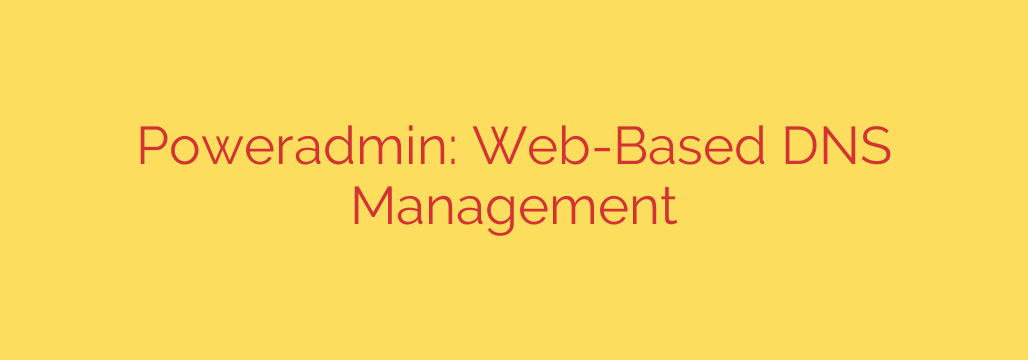
Simplify DNS Management with Poweradmin: A Comprehensive Guide
Managing Domain Name System (DNS) records can be a complex and unforgiving task. For system administrators and developers, editing zone files directly through a command-line interface is not only time-consuming but also fraught with the risk of syntax errors that can take entire domains offline. Fortunately, web-based tools have emerged to streamline this process, and one of the most robust solutions available is Poweradmin.
Poweradmin is a free, open-source web-based control panel specifically designed for managing DNS services, with a primary focus on the PowerDNS server. It provides an intuitive graphical user interface (GUI) that transforms the often-tedious task of DNS management into a simple, efficient, and far less error-prone activity. By leveraging a web front-end, you can manage your DNS records from anywhere, without needing to SSH into a server.
Key Features That Make Poweradmin Stand Out
Poweradmin is packed with features that cater to both simple and complex DNS setups. Whether you’re managing a single domain or hundreds, this tool offers the flexibility and power you need.
Complete Support for All Common Record Types: Poweradmin allows you to easily create, edit, and delete a wide range of DNS records. This includes essential records like A (IPv4), AAAA (IPv6), CNAME (alias), MX (mail exchange), TXT (text), and SRV (service) records. This comprehensive support ensures you can configure your domains for any application, from web hosting to email and custom services.
Robust User and Permission Management: For organizations with multiple team members, Poweradmin offers granular control over user access. You can create different user accounts and assign specific permissions, ensuring that only authorized personnel can make changes. For example, you can grant a junior administrator rights to manage specific zones while reserving master administrative privileges for senior staff.
Powerful Zone Template System: One of the most significant time-saving features is the ability to create zone templates. If you frequently set up new domains with similar DNS configurations (e.g., with standard MX and CNAME records for web and email), you can create a template. Applying a template to a new domain automatically populates it with all the predefined records, reducing manual setup time from minutes to seconds.
Built-in DNSSEC Support: Security is paramount, and Poweradmin makes it easier to implement DNSSEC (Domain Name System Security Extensions). DNSSEC helps protect your domain from spoofing and cache poisoning attacks by cryptographically signing your DNS data. Poweradmin provides a user-friendly interface to manage DNSSEC keys and sign your zones, a task that can be incredibly complex to perform manually.
Flexible Database Backend: While it works seamlessly with PowerDNS, Poweradmin is built to interact with a database backend (like MySQL, MariaDB, or PostgreSQL) where the DNS information is stored. This architecture not only makes it highly scalable but also separates the management interface from the DNS server itself, adding a layer of resilience to your infrastructure.
Actionable Security and Management Tips
To get the most out of your Poweradmin installation, it’s crucial to follow best practices for both security and operational efficiency.
Secure Your Installation: Like any web application, your Poweradmin instance should be properly secured. Always install it on a server with HTTPS enabled to encrypt traffic between your browser and the server. Use strong, unique passwords for the Poweradmin administrative account and the database user it connects with. Finally, keep both Poweradmin and your underlying server software updated to protect against known vulnerabilities.
Back Up Your DNS Database Regularly: Since all your DNS records are stored in a database, this database becomes a critical piece of your infrastructure. Implement a regular, automated backup schedule for your DNS database. In the event of a server failure or accidental data deletion, having a recent backup will allow for a swift and complete recovery.
Use Granular Permissions Wisely: Avoid the temptation to give every user full administrative rights. Instead, follow the principle of least privilege. Create user roles with permissions tailored to their specific responsibilities. This minimizes the risk of accidental misconfigurations and enhances your overall security posture.
In conclusion, Poweradmin is an indispensable tool for anyone looking to simplify their DNS management workflow. By replacing complex command-line editing with an intuitive, feature-rich web interface, it drastically reduces the potential for human error while saving valuable time. Its support for templates, DNSSEC, and multi-user environments makes it a powerful, professional-grade solution for managing any PowerDNS-based infrastructure.
Source: https://www.linuxlinks.com/poweradmin-web-based-dns-administration-tool/








